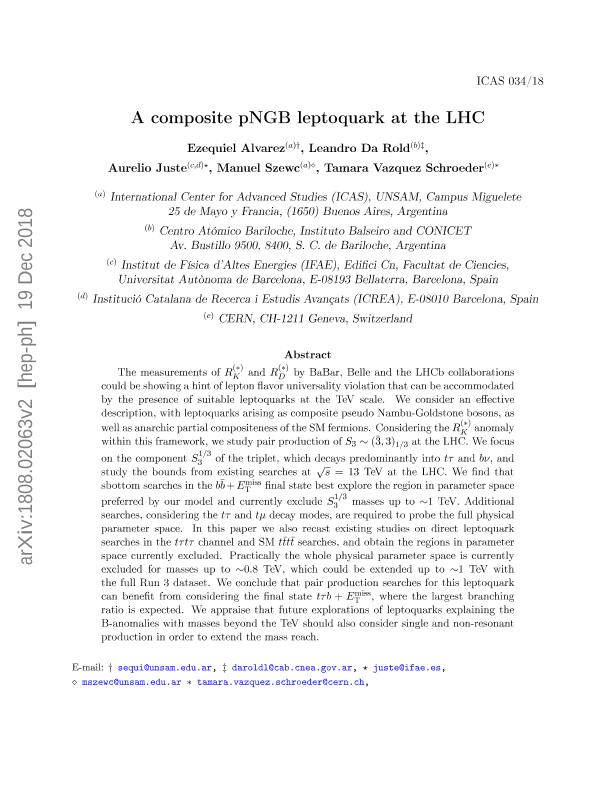Artículo
The measurements of RK (∗) and RD (∗) by BaBar, Belle and the LHCb collaborations could be showing a hint of lepton flavor universality violation that can be accommodated by the presence of suitable leptoquarks at the TeV scale. We consider an effective description, with leptoquarks arising as composite pseudo Nambu-Goldstone bosons, as well as anarchic partial compositeness of the SM fermions. Considering the RK (∗) anomaly within this framework, we study pair production of S3∼ (3 ¯ 3) 1 / 3 at the LHC. We focus on the component S3 1/3 of the triplet, which decays predominantly into tτ and bν, and study the bounds from existing searches at s=13 TeV at the LHC. We find that sbottom searches in the bb¯+ETmiss final state best explore the region in parameter space preferred by our model and currently exclude S3 1/3 masses up to ∼1 TeV. Additional searches, considering the tτ and tμ decay modes, are required to probe the full physical parameter space. In this paper we also recast existing studies on direct leptoquark searches in the tτ tτ channel and SM tt¯ tt¯ searches, and obtain the regions in parameter space currently excluded. Practically the whole physical parameter space is currently excluded for masses up to ∼0.8 TeV, which could be extended up to ∼1 TeV with the full Run 3 dataset. We conclude that pair production searches for this leptoquark can benefit from considering the final state tτ b + ET miss, where the largest branching ratio is expected. We appraise that future explorations of leptoquarks explaining the B-anomalies with masses beyond the TeV should also consider single and non-resonant production in order to extend the mass reach. The measurements of R (∗) K and R (∗) D by BaBar, Belle and the LHCb collaborations could be showing a hint of lepton flavor universality violation that can be accommodated by the presence of suitable leptoquarks at the TeV scale. We consider an effective description, with leptoquarks arising as composite pseudo Nambu-Goldstone bosons, as well as anarchic partial compositeness of the SM fermions. Considering the R (∗) K anomaly within this framework, we study pair production of S3 ∼ (¯3, 3)1/3 at the LHC. We focus on the component S 1/3 3 of the triplet, which decays predominantly into tτ and bν, and study the bounds from existing searches at √ s = 13 TeV at the LHC. We find that sbottom searches in the b ¯b + Emiss T final state best explore the region in parameter space preferred by our model and currently exclude S 1/3 3 masses up to ∼1 TeV. Additional searches, considering the tτ and tµ decay modes, are required to probe the full physical parameter space. In this paper we also recast existing studies on direct leptoquark searches in the tτ tτ channel and SM ttt¯ t¯ searches, and obtain the regions in parameter space currently excluded. Practically the whole physical parameter space is currently excluded for masses up to ∼0.8 TeV, which could be extended up to ∼1 TeV with the full Run 3 dataset. We conclude that pair production searches for this leptoquark can benefit from considering the final state tτ b + Emiss T , where the largest branching ratio is expected. We appraise that future explorations of leptoquarks explaining the B-anomalies with masses beyond the TeV should also consider single and non-resonant production in order to extend the mass reach.
A composite pNGB leptoquark at the LHC
Fecha de publicación:
12/2018
Editorial:
Springer
Revista:
Journal of High Energy Physics
ISSN:
1029-8479
e-ISSN:
1126-6708
Idioma:
Inglés
Tipo de recurso:
Artículo publicado
Clasificación temática:
Resumen
Palabras clave:
BEYOND STANDARD MODEL
,
EXOTICS
,
HADRON-HADRON SCATTERING (EXPERIMENTS)
Archivos asociados
Licencia
Identificadores
Colecciones
Articulos(CCT - PATAGONIA NORTE)
Articulos de CTRO.CIENTIFICO TECNOL.CONICET - PATAGONIA NORTE
Articulos de CTRO.CIENTIFICO TECNOL.CONICET - PATAGONIA NORTE
Citación
Alvarez, Ezequiel; Da Rold, Leandro; Juste, Aurelio; Szewc, Manuel; Schroeder, Tamara Vazquez; A composite pNGB leptoquark at the LHC; Springer; Journal of High Energy Physics; 2018; 27; 12-2018; 1-19
Compartir
Altmétricas




